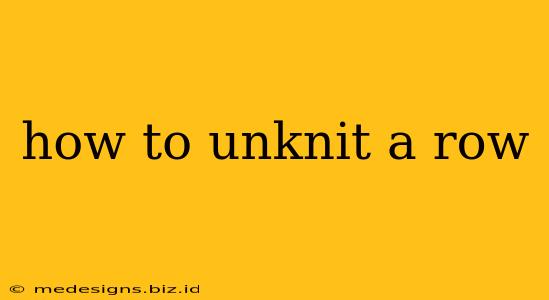So, you've made a mistake in your knitting. Don't worry, it happens to the best of us! Unraveling a row or even several rows is a crucial skill for every knitter, from beginner to expert. This guide will teach you how to unknit a row cleanly and efficiently, preserving your yarn and your sanity.
Understanding the Basics of Unknitting
Before we dive into the techniques, it's important to understand what we're doing. Unknitting isn't just pulling the yarn; it's carefully transferring stitches back onto the needle, maintaining their integrity. This ensures your work doesn't become tangled or damaged, and allows you to easily correct your mistakes.
Essential Tools
While you don't need special tools to unknit a row, having a few handy items can make the process much easier:
- A crochet hook: A small hook can be extremely useful for gently picking up dropped stitches.
- A spare needle: Having a second needle can help keep your unknitted stitches organized.
- Good lighting: Proper lighting will prevent eye strain and ensure you don't miss any stitches.
- Patience: Unknitting can be time-consuming, especially with intricate patterns. Patience is key!
Methods for Unknitting a Row
There are two primary methods for unknitting a row, each with its own advantages:
Method 1: Using the Needle
This is the most common method and is generally preferred for most situations.
- Identify the last stitch: Locate the very last stitch you knit on your current row.
- Slip the stitch: Using your left needle, gently slip the last stitch off the needle.
- Unknit the stitch: Insert the tip of your left needle into the stitch you just slipped. Carefully “un-knit” the stitch by lifting the loop of yarn over the needle tip, pulling it through the stitch, and transferring it to your left needle.
- Continue unknitting: Repeat steps 2 and 3 for each stitch in the row, working backward. Keep the unknitted stitches organized on your left needle.
Tip: If you encounter any resistance, gently tug on the yarn tail to loosen the stitches. Be careful not to pull too hard, as you could damage the yarn.
Method 2: Using a Crochet Hook (for tricky situations)
Sometimes, stitches can become quite tight or tangled. In these cases, a crochet hook can be a lifesaver.
- Insert the hook: Insert the crochet hook into the last stitch on your needle.
- Yarn over and pull through: Yarn over your hook and gently pull the loop through the stitch.
- Transfer to needle: Transfer the newly unknitted stitch to your left needle.
- Continue unknitting: Repeat steps 1-3 for each stitch in the row.
This method can be particularly helpful when dealing with complex stitch patterns or heavily twisted stitches.
Preventing Future Unknitting
While knowing how to unknit is a valuable skill, it's always better to prevent mistakes in the first place! Here are some tips:
- Read your pattern carefully: Take your time to understand the instructions before you begin knitting.
- Count your stitches regularly: Get into the habit of counting your stitches at the end of each row to catch errors early on.
- Use stitch markers: Stitch markers are your friends! They can help you track increases, decreases, and pattern repeats, reducing the likelihood of mistakes.
- Work in a well-lit area: Good lighting helps you see your work clearly and avoid errors.
Unknitting a row might seem daunting at first, but with practice, it becomes second nature. By mastering these techniques, you'll be able to confidently correct mistakes and continue creating beautiful knitted projects!
